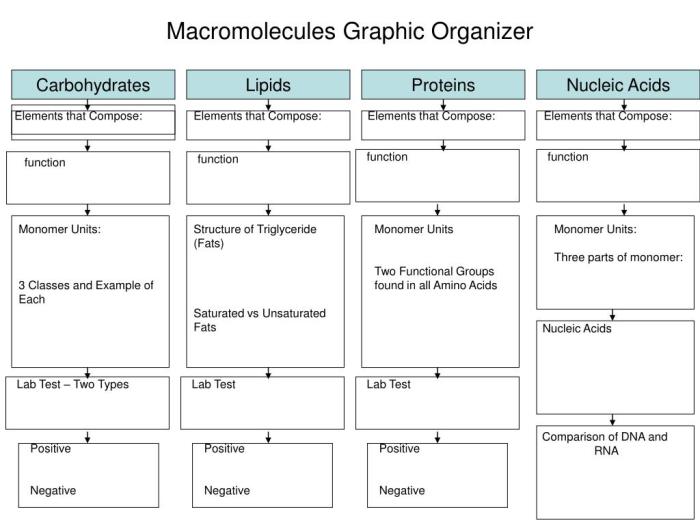Embark on an enlightening journey with our Introduction to Biological Macromolecules Quiz, where we unravel the intricacies of these fundamental components of living organisms. Dive into a world of carbohydrates, proteins, lipids, and nucleic acids, exploring their structures, functions, and significance in our everyday lives.
From the intricate dance of molecular biology to the groundbreaking advancements in biotechnology, biological macromolecules hold the key to unlocking the secrets of life. Prepare to be captivated as we delve into the fascinating realm of these essential molecules.
1. Define Biological Macromolecules

Biological macromolecules are complex, large molecules that are essential for life. They are composed of repeating units called monomers, which are linked together to form polymers. Biological macromolecules include carbohydrates, proteins, lipids, and nucleic acids.
Types of Biological Macromolecules, Introduction to biological macromolecules quiz
Biological macromolecules can be classified into four main types based on their chemical composition:
- Carbohydrates: Composed of carbon, hydrogen, and oxygen atoms, carbohydrates are the body’s primary source of energy.
- Proteins: Composed of amino acids, proteins are essential for cell structure and function.
- Lipids: Composed of fatty acids and glycerol, lipids are used for energy storage and insulation.
- Nucleic acids: Composed of nucleotides, nucleic acids store and transmit genetic information.
Structure and Function of Biological Macromolecules
The structure of biological macromolecules determines their function. Carbohydrates are composed of simple sugars linked together to form complex structures, such as starch and cellulose. Proteins are composed of amino acids linked together to form chains, which fold into specific shapes to perform specific functions.
Lipids are composed of fatty acids and glycerol linked together to form a variety of structures, including fats and oils. Nucleic acids are composed of nucleotides linked together to form long chains, which contain the genetic code.
Biological Macromolecules in Everyday Life
Biological macromolecules are used in a wide variety of industries. Carbohydrates are used in the food industry as sweeteners and thickeners. Proteins are used in the food industry as a source of nutrition and in the pharmaceutical industry as drugs.
Lipids are used in the food industry as a source of energy and in the cosmetics industry as moisturizers. Nucleic acids are used in the medical industry for genetic testing and in the biotechnology industry for genetic engineering.
Advanced Concepts in Biological Macromolecules
Advanced concepts in biological macromolecules include molecular biology and biotechnology. Molecular biology is the study of the structure and function of biological macromolecules. Biotechnology is the use of biological macromolecules to create new products and processes.
General Inquiries: Introduction To Biological Macromolecules Quiz
What are biological macromolecules?
Biological macromolecules are large, complex molecules that are essential for the structure and function of living organisms.
What are the four main types of biological macromolecules?
The four main types of biological macromolecules are carbohydrates, proteins, lipids, and nucleic acids.
What is the function of carbohydrates?
Carbohydrates provide energy for cells and serve as structural components.
What is the function of proteins?
Proteins perform a wide range of functions, including catalysis, transport, and structural support.
What is the function of lipids?
Lipids store energy, form cell membranes, and act as hormones.
What is the function of nucleic acids?
Nucleic acids store and transmit genetic information.

